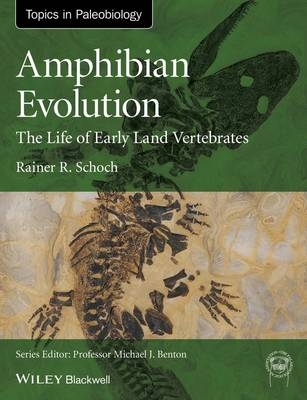
Amphibian Evolution
Wiley-Blackwell (Verlag)
978-0-470-67177-1 (ISBN)
- Titel ist leider vergriffen;
keine Neuauflage - Artikel merken
Books in the series provide a summary of the current state of knowledge, a trusted route into the primary literature, and will act as pointers for future directions for research. As well as volumes on individual groups, the series will also deal with topics that have a cross-cutting relevance, such as the evolution of significant ecosystems, particular key times and events in the history of life, climate change, and the application of a new techniques such as molecular palaeontology. The books are written by leading international experts and will be pitched at a level suitable for advanced undergraduates, postgraduates, and researchers in both the paleontological and biological sciences.
Rainer Schoch, born 1970 in Ludwigshafen, Germany. He graduated at the University of Tubingen, undertook field work in Argentina and the USA, and worked as a curator and assistant professor at Humboldt University Berlin. Since 2003 he has been the curator of amphibians and reptiles at the Natural History Museum of Stuttgart, Germany.
Preface viii Acknowledgments x 1 Introduction 1 1.1 Changing paradigms in amphibian evolution 3 1.2 Paleobiology: data, methods, and time scales 5 1.3 Concepts and metaphors: how scientists figure out problems 7 1.4 Characters and phylogenies 8 1.5 What s in a name? 8 References 11 2 The Amphibian World: Now and Then 13 2.1 Tetrapoda 14 2.1.1 The tetrapod skeleton 14 2.1.2 Tetrapod characters 23 2.1.3 Stem-tetrapods (Tetrapodomorpha) 25 2.1.4 Carboniferous tetrapods or tetrapodomorphs? 31 2.2 The amniote stem-group 32 2.2.1 Anthracosauria 33 2.2.2 Seymouriamorpha 37 2.2.3 Chroniosuchia 38 2.2.4 Lepospondyli 40 2.2.4.1 Lepospondyl characters 42 2.2.4.2 Microsauria 42 2.2.4.3 Lysorophia 44 2.2.4.4 Nectridea 44 2.2.4.5 Aistopoda 45 2.2.4.6 Adelospondyli 46 2.2.4.7 Acherontiscidae 46 2.2.5 Gephyrostegida 46 2.2.6 Amniota 47 2.2.6.1 Stem-amniotes and early crown amniotes 48 2.3 The lissamphibian stem-group (Temnospondyli) 48 2.3.1 Edopoidea 51 2.3.2 Dendrerpeton and Balanerpeton 53 2.3.3 Dvinosauria 54 2.3.4 Dissorophoidea and Zatracheidae 54 2.3.5 Eryopoidea 56 2.3.6 Stereospondyli 57 2.4 Albanerpetontidae 58 2.5 Lissamphibia 59 2.5.1 Lissamphibian characters 61 2.5.2 Batrachia 62 2.5.2.1 Anura (frogs and toads) 62 2.5.2.2 Caudata (salamanders) 67 2.5.2.3 Gymnophiona (caecilians) 68 References 70 3 Amphibian Life Through Time 81 3.1 Aquatic predators prepare for land 83 3.2 Hot springs, scorpions, and little creepers 83 3.3 Life in the tropical coal forest 85 3.4 Neotenes explore unfavorable waters 89 3.5 Lowlands, uplands, and a cave 90 3.6 Hide and protect: extreme life in the hothouse 94 3.7 Predators in deltas, lakes, and brackish swamps 97 3.8 Stereospondyls in refugia, lissamphibians on the rise 97 3.9 Batrachians diversify, stereospondyls disappear 100 3.10 Lissamphibians expand into diverse habitats 101 References 102 4 The Amphibian Soft Body 106 4.1 How to infer soft tissues in extinct taxa 107 4.2 Fossil evidence: soft tissue preservation 109 4.3 Head and visceral skeleton 110 4.4 Respiratory organs 113 4.5 Lateral lines, electroreception, and ears 118 References 122 5 Evolution of Functional Systems 126 5.1 How paradigms and brackets give a functional scenario 127 5.2 Feeding and breathing under water 131 5.3 Decoupling breathing and feeding 134 5.4 Hearing: exapting the spiracle and hyomandibula 136 5.5 Respiration in early tetrapods 141 5.6 The evolution of terrestrial feeding 143 5.7 Transforming fins into limbs 144 5.8 Locomotion in paleozoic tetrapods 146 References 148 6 Development and Evolution 152 6.1 Ontogeny in modern amphibians 153 6.2 Fossil ontogenies 158 6.3 Ontogeny as a sequence: developmental trajectories 163 6.4 Histology: the skeleton as archive 167 6.5 Changing shape: allometry 171 6.6 Heterochrony: the evolution of development 174 6.7 Body plans: gene regulation and morphogenesis 179 References 184 7 Paleoecology 191 7.1 Lissamphibian ecology 192 7.2 Paleoecology: problems and perspectives 193 7.3 Paleozoic and Mesozoic amphibians 196 7.4 Amphibian evolution as a walk through trophic levels 203 References 205 8 Life History Evolution 208 8.1 Plasticity, reaction norm, and canalization 209 8.2 Reaction norms in extant amphibians 210 8.3 The biphasic life cycle in lissamphibians 211 8.4 Seymouriamorphs: biphasic life cycles without metamorphosis 213 8.5 Temnospondyls: flexible uni- and biphasic ontogenies 213 8.6 Lepospondyls: dwarfism and uniphasic life cycles 215 8.7 The evolution of metamorphosis 216 8.8 The evolution of neoteny 216 8.9 General features of life history evolution 217 References 219 9 Phylogeny 222 9.1 Phylogeny of amphibians 223 9.2 The big picture: tetrapod diversification 223 9.3 The origin of lissamphibians 224 References 231 10 Macroevolution 234 10.1 What is macroevolution? 235 10.2 Patterns of early tetrapod evolution 235 10.3 Major factors of amphibian evolution 240 10.4 Clades, space, and time 248 10.5 Diversity, disparity, and extinction 249 10.6 The evolution of terrestriality 252 References 254 Index 260 Plate section between pp. 124 and 125
| Erscheint lt. Verlag | 5.5.2014 |
|---|---|
| Reihe/Serie | TOPA Topics in Paleobiology |
| Verlagsort | Hoboken |
| Sprache | englisch |
| Maße | 185 x 264 mm |
| Gewicht | 820 g |
| Themenwelt | Naturwissenschaften ► Biologie ► Evolution |
| Naturwissenschaften ► Biologie ► Zoologie | |
| Naturwissenschaften ► Geowissenschaften ► Geologie | |
| Naturwissenschaften ► Geowissenschaften ► Mineralogie / Paläontologie | |
| ISBN-10 | 0-470-67177-7 / 0470671777 |
| ISBN-13 | 978-0-470-67177-1 / 9780470671771 |
| Zustand | Neuware |
| Haben Sie eine Frage zum Produkt? |
aus dem Bereich


